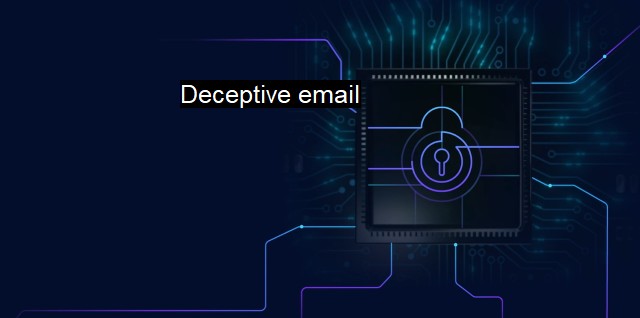What is Deceptive email?
Deceptive Emails and Cyberattacks: A Comprehensive Analysis of Phishing, Malware, and their Consequences.
Deceptive email, famously known as phishing, is a term that has considerably gained prominence in the fields of cybersecurity and antivirus considering its relations to online fraudulent activities. As machines and user interactions increasingly adopt the digital space, bad actors are seizing opportunities that arise from undeveloped online landscapes to trick unwary users into disclosing sensitive data. This particular trend continually threatens the integrity of online cybersecurity and necessitates the development of strong antivirus systems.The term "deceptive email" primarily refers to messages that are designed and crafted with an aim to deceive or defraud recipients by impersonating legitimate organizations or individuals. These are detailed schemes that so meticulously mimic the characteristic brand-corporate identity or personal emails to a nearly flawless precision that an untrained eye would easily fall into the trap. The content within these emails often attempts to provoke an immediate response from the recipients, leveraging scary warnings, sounding alerts, or highly appealing offers, hence distracting the would-be victims from conducting proper due diligence by cross-verifying information, contextual clues, and specialized system alerts.
Based on the fundamental objectives of initiating deceptive emails, such virtual threats generally fall into two main categories. There are phishing emails that are broadly dispatched to numerous recipients in a shotgun-like fashion, hoping that at least a limited percentage of the recipients will get tricked. These emails usually contain generic messaging and offers that strongly resonate with a broad user market profile.
On the other hand, there are spear-phishing emails that have a much narrower and focused target group which often includes select individuals or organizations. Due to their targeted nature, these emails contain more personalized messages, capable of infiltrating strong firewalls since the unsuspecting victims are often tricked into deactivating certain security protocols.
Deceptive emails often come with harmful attachments or embedded links that either open up to fraudulent websites or directly deploy malware into the recipient's system. This leads to revealing sensitive information such as usernames, passwords, and financial details, prompting the chance of financial loss for victims. such emails introduce corrupt files into the recipient's device resulting in system compromise, giving hackers unauthorized access to one’s system, enabling data theft and promoting other illegitimate activities.
The threat that deceptive emails pose to both individuals and organizations is paramount. They can break an organization's integrity by exposing or stealing confidential project details, client data, or financial details. they potentially cause great financial losses and lawsuits due to a violation of data protection and consumer rights. In consideration of individuals, it puts their personal and financial information at great risk while also corrupting systems and processors beyond repairable extents in some cases.
In response to these threats, cybersecurity has considerably developed advanced protocols and antivirus systems that incorporate both behavioral and signature analysis to detect and block potential fraudulent activities. Strong filters within the email provider's infrastructure are designed to segregate deceptive emails, along with custom alerts to inform users of potential phishing attempts. Besides, opting for strong firewall protection and regularly updating the system's antivirus software can offer robust online safety.
Building awareness is an equally important countermeasure. Understanding the main ingredients within such deceptive mixtures and learning the available protective measures count remarkably towards achieving assured online safety. Although technology can provide safety nets, the ability of individuals to critically identify and manage deceptive emails is at the heart of this digital-world defense mechanism.
Undoubtedly, deceptive emails are silent, powerful cybercriminal tools deployed to defraud unsuspecting users continuously. As deceiving as these can be, an aware user equipped with robust antivirus mechanisms is potentially harmful to these fraudulent actors and such malicious activities. Complementing technological innovations with education about mechanisms behind deceptive emails, potential risks, and countermeasures can truly establish a formidable front against such cyber threats.

Deceptive email FAQs
What is a deceptive email?
A deceptive email is an unsolicited email that is designed to trick the recipient into believing it is legitimate. Such emails may include fraudulent links, attachments or other deceptive tactics to obtain sensitive information or install malware on your device.How can I recognize a deceptive email?
Deceptive emails usually have telltale signs such as incorrect grammar and spelling, urgent requests for personal information, suspicious attachments, and unfamiliar or suspicious sender addresses. Exercise caution when opening emails from unknown senders or messages that seem too good to be true.What should I do if I receive a deceptive email?
If you receive a deceptive email, do not click on any links or download any attachments. Instead, delete the message immediately. Additionally, it is important to report the email to your IT department, the Antivirus company or the relevant authorities to help prevent others from falling victim to scams.How can I protect myself from deceptive emails?
To protect yourself from deceptive emails, always be cautious when opening emails from unknown senders. Keep your antivirus software updated and avoid entering sensitive information on suspicious websites. Always verify the sender's identity before clicking on any links or downloading attachments. Also, be sure to educate yourself and others around you about the dangers of phishing and other forms of cybercrime.| | A | | | B | | | C | | | D | | | E | | | F | | | G | | | H | | | I | | | J | | | K | | | L | | | M | |
| | N | | | O | | | P | | | Q | | | R | | | S | | | T | | | U | | | V | | | W | | | X | | | Y | | | Z | |
| | 1 | | | 2 | | | 3 | | | 4 | | | 7 | | | 8 | | |||||||